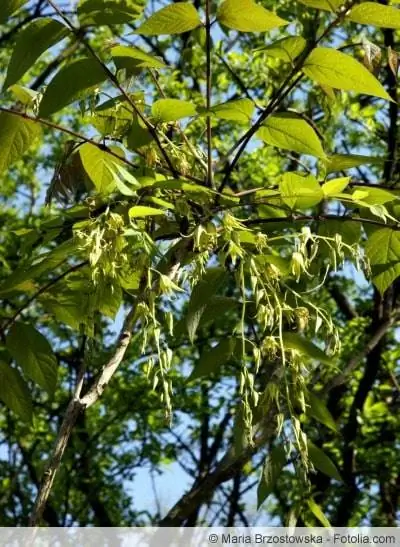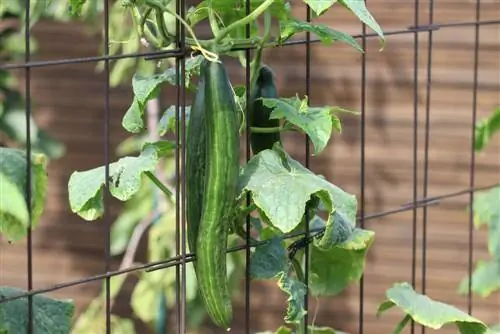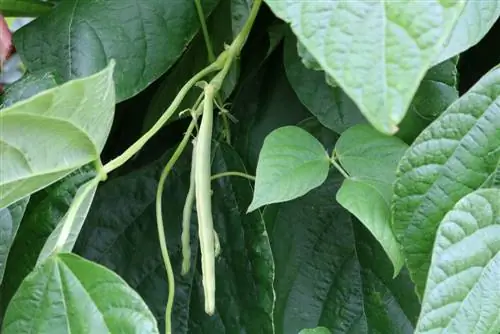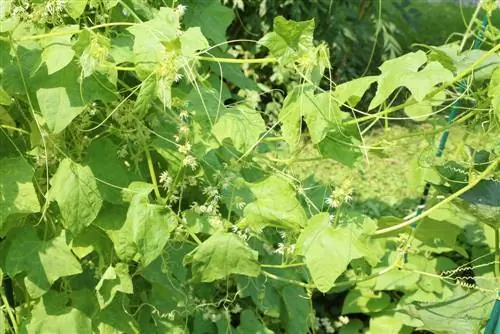- Author admin [email protected].
- Public 2023-12-17 03:39.
- Last modified 2025-01-24 12:45.
Despite the exotic origins and appearance of the shrub, growing the blue pod is surprisingly easy and requires little effort in terms of care. However, extremely worthwhile. From the color of the fruit and the delicate taste to the impressive size of the feathery leaves, the cucumber bush is more than just an eye-catcher. It can also be cultivated outdoors as well as in the winter garden or living room and steals the show from many other plants.
Location
The blue pod comes from the wooded regions of western China and is originally used to sheltered locations. It also needs sun to partial shade and wind protection in this country. The optimal location is therefore a sheltered location, for example a warm corner close to the house. Neither the blazing midday sun should hit it, nor cold or strong wind. This protection is particularly crucial in winter. If you decide to plant directly outdoors, you also have to take the space required into account. Without cuttings, the cucumber bush can reach five meters in height and four meters in width. As a result, the blue pod bush easily overshadows other plants. However, at around a quarter of a meter per year, it takes a while for this to happen. Nevertheless, sufficient distance from the house and walls should be planned or the blue pod should first be grown in a bucket.
Substrate
Fresh to moist, nutrient-rich or lean, alkaline to acidic: the substrate for the blue pod and its cultivation is unproblematic. Deep garden soil that is well-drained is optimal. However, the substrate should not tend to compact and experience has shown that lean soil is the better choice for the blue pod bush. Garden soil should therefore be loosened with sand or gravel if possible. Rich doses of fertilizer of any kind should be avoided. If the soil is heavily used up, some mulch or rotted compost can be added as preparation. However, the prerequisite is that the nutrient application can be distributed and settled evenly in the soil for at least a few weeks before the cucumber bush is planted or sowing takes place.
Sowing and Planting
The blue pod can be propagated both from seeds and cuttings. Accordingly, it is possible to start growing the cucumber bush in different ways. If you don't want to wait too long for the first fruits, choose early-grown young plants. To grow from seeds, proceed as follows:
- The blue pod seeds require a cold period to germinate. The so-called stratification is achieved by storing the seeds at around 5°C for two to three months. For example, in the refrigerator. Alternatively, the seeds can be placed in soil and “cold” in it.
- Soaked in lukewarm water, the seeds are prepared for germination for a day. In a planter they are lightly covered with potting soil. The substrate is moistened, but should not be soaked.
- For quick yet strong sprouting, the container is placed in a bright and warm location. 20 to 25 °C is necessary for germination to begin.
- A cover to keep moist is not necessary. However, the potting soil should be watered regularly, although waterlogging should be avoided.
A mixture of commercially available growing substrate with sand or perlite is recommended as growing soil when sowing the blue pod. When propagating via cuttings, however, the soil described above can be used directly. Here, too, a few points should be taken into account:
- If you start growing blue pods with cuttings, you should take them in spring or early summer if possible and then quickly plant them in the ground.
- The cuttings, which are at least ten centimeters long, are powdered with rooting aid at the interface and then planted a few centimeters deep in soil. They should stop on their own.
- The substrate is well moistened and subsequently kept moist, but should never be wet.
- A warm and bright place that is protected from wind and late frosts should be chosen as the location for the cuttings and young plants to be rooted.
It usually only takes a few weeks for the cuttings to root. Successful rooting can be recognized by the fact that the plant shoots can no longer be pulled out of the ground or new leaves form.
Tip:
Of course, as already mentioned, the cultivation of the cucumber bush can also begin with early young plants. This is actually the best way to get a quick return. The plants are planted in early summer, when delayed sub-zero temperatures are no longer to be expected.
Pouring
Whether planted freely in the garden or in a container, the blue pod bush requires fairly consistent moisture. However, he must never be drowned. The plant tolerates drought much better than waterlogging. Therefore, it can be left drier from time to time, but it is better not to use a planter or saucer outdoors. For this reason, it also makes sense to give it a drainage layer when growing it in a container. This can consist of potsherds or coarse gravel and protects the roots from rotting if there is too much water.
Fertilize
As already mentioned, the blue pod bush thrives better on poor soil. Of course, it cannot function entirely without nutrients. From the second year onwards, long-term fertilizer for vegetable plants should be administered in low doses. Fertilization is carried out when the shrub already shows the first new shoots, i.e. in late spring or early summer. A product that lasts for six months should be preferred, as the amount gradually decreases and does not need to be fertilized again.
Harvest
In summer, the blue pod produces fruits whose shells gradually turn blue. These are not only reminiscent of beans in appearance, but are also harvested and peeled in the same way - but can be eaten raw. The right time has come when the shells have turned cob alt blue. So in late summer.
Tip:
If you can't put all the blue peppers on your menu, you can also use them fresh or dried as decoration.
Wintering
The blue pod bush can tolerate frost, but only down to -10 °C. The most important protection in winter is still the right location. Cold winds and blazing winter sun should, if possible, not affect the blue pod. Additional insulation also makes sense. Since the plant sheds its leaves in autumn anyway, the cucumber bush can be completely wrapped in garden fleece or blankets. Piling up straw, brushwood or mulch protects the roots.
If the blue pod is cultivated in a container or if it is a very young plant, overwintering outdoors is not recommended. It is then better to give the plant a frost-free winter quarters. Temperatures between five and ten degrees are ideal here. By the way, caution is still advised in spring. The cucumber bush sprouts quite early, but is very sensitive to late frosts. In the event of sudden drops in temperature, the plant should be protected again or brought indoors.
Tip:
Even in winter, the blue pod must not dry out and should therefore be watered sipwise if necessary.
Blend
Blending the blue pod is not absolutely necessary, but it can be done if necessary. If the plant becomes too large, careful pruning is recommended; frozen or otherwise damaged shoots may also be cut off.
Ideally, the cutting is carried out after the last frost.
Bucket Culture
Since the blue pod is not particularly frost-resistant, growing it in a bucket is recommended, at least for the first few years. This makes wintering much easier. In addition, the cucumber bush can also serve as a houseplant thanks to its decorative look. If you still want to grow the blue pods productively, you should take the plant outside to bloom in May or June. Here insects ensure that the flowers are fertilized and that the slightly sweet fruits can emerge from them. The greater water requirement should be taken into account when cultivating in containers. At the same time, the risk of waterlogging is more present, so no water should be left in the planter or saucer.
Conclusion
The blue pod is an exotic addition to the garden, balcony or living room and the menu. This doesn't require a lot of care, but you must have the right knowledge about the culture and cultivation of the cucumber bush.






